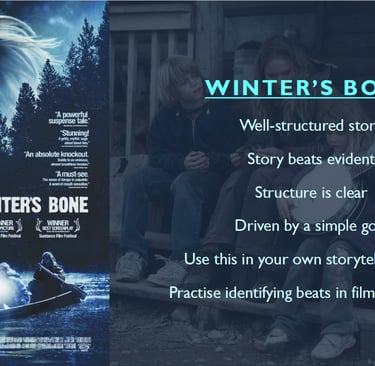Understanding Structure
What Winter's Bone Teaches About Screenplay Fundamentals
SCRIPT, STORYBOARD AND PREVIS
Drew Campbell
10/29/20252 min read


Understanding structure:
What Winter's Bone teaches us about screenplay fundamentals
In class, we examined Winter's Bone (2010) as an example of a tightly structured screenplay. Phil, our tutor, used Debra Granik's film to illustrate the fundamental principles of Goals, Stakes, and Urgency (GSU), the principles that drive compelling narratives. Ree Dolly's goal is clear: find her father Jessup before the family loses their house, which was used as bail bond collateral. The stakes are devastating: homelessness for Ree and her younger siblings. The urgency is built in: a deadline looms before the property is forfeit.
We also studied the screenplay's formatting and economy. The opening pages establish the Ozark setting efficiently: "wintry hollow, large trailer, American flag." Character introductions are sparse but visual: "REE – 17, hanging laundry." Names are capitalised only on first appearance; subsequent mentions use standard formatting. Action lines remain functional: "buttons Ashley's doll's dress, hands it to her, picks up laundry basket." Phil emphasised this economy: screenwriting differs fundamentally from novel writing. You haven't got the luxury of space on the page. Select a few key details to convey ideas quickly, clearly, and visually. The script conveys maximum information in minimal words, like a recipe everyone on set works from; the art department, actors, and director all build from this blueprint.
When assigned to compare the screenplay to the finished film, I misunderstood the task. I documented minor dialogue variations—such as contractions, word order changes, and ad-libs, thinking these represented the adaptation process. I noted that Merab says "Told you to leave him be" instead of the scripted "Told you I said to leave him be," that Ree says "My mom's sick" rather than "My mom is sick," that Teardrop adds "that" before "fucking sheriff." These changes reveal how actors naturally refine dialogue for authenticity, but they weren't what I should have been analysing. What I should have been tracking were the story beats and how GSU principles manifested throughout the narrative structure.
My research revealed that the real creative work happened earlier, during the book-to-script phase. Granik and co-writer Anne Rosellini restructured Ree's journey from Daniel Woodrell's novel, avoiding repetitive rejections by ensuring each encounter advanced the story (Cohen, 2016). They simplified the dialect for clarity, though actor John Hawkes later restored authenticity based on character research (Cohen, 2016).
Winter's Bone demonstrates that effective screenwriting requires clear structural principles from the start. The minor performance adjustments I catalogued simply refined an already solid foundation.


References:
FROM SCRIPT TO SCREEN: ‘Winter’s Bone’ by David S. Cohen (2016) https://scriptmag.com (accessed: 17 October 2025)




Business address: Voice of Drew, Carlisle, CA2 6ER | UTR: 7259771174 Copyright Drew Campbell 2024
